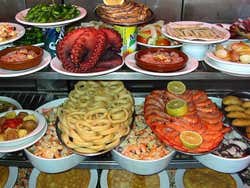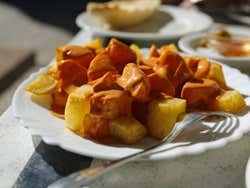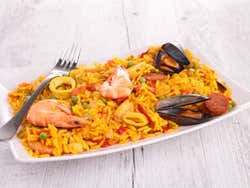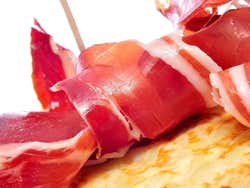
Where to Eat in Madrid
Madrid’s gastronomy is very varied and could be described as a mix of Spanish cuisine from various regions. The dishes are normally tasty, filling and are usually ordered to share.
Going out for tapas in Madrid is a great tradition and the city is full of tapas bars or taverns. Most of the capital’s traditional dishes are served as “raciones”, large portions which are ordered to share with your friends or family. Another perk about Madrid is that a lot of restaurants serve food throughout the day, so you won’t have to worry about having a tight schedule during your holidays.
Although Madrid is not a coastal city, it has numerous quality seafood restaurants. One of the most popular seafood dishes is called “calamares a la romana” (fried squid). There are several bars that offer delicious fried squid sandwiches around Plaza Mayor, a must if you haven’t tried it!
Traditional dishes
Madrid has several typical dishes, some of which can also be found in other regions, with slightly different ingredients. These are some of the most popular dishes:
- Orejas a la plancha: Grilled pig ear with garlic and parsley. It is usually served with chips.
- Bocadillo de calamares: Although it is not a coastal town, squid sandwiches are one of the options that come to mind when looking for what to eat in Madrid. Especially popular are the calamari sandwiches in Madrid's Plaza Mayor.
- Gallinejas: Deep-fried lamb insides and intestines.
- Caracoles a la madrileña: “Madridleñan snails”, snails that have been cooked slowly in a meat broth, which is sometimes a little spicy.
- Cocido madrileño: Very traditional chickpea-based stew with meat.
- Callos a la madrileña: Made with pig stomach, chorizo, ham, tomato and paprika, this dish is usually served in winter.
- Soldaditos de Pavia: Little bits of battered and fried cod served with red peppers.
- Huevos estrellados: Fried egg with chips, ham, chorizo or chistorra (fast-cure sausage).
- Pastas del consejo: Known as "Senate Pastries" these small lemon biscuits were made for the first time for King Alfonso XII during the nineteenth century.
- Rosquillas tontas y listas: A type of ring-shaped pastry, only made in May. The “listas” have a layer of icing sugar.
- Rosquillas de Santa Clara: These rosquillas taste of anise and have a layer of icing sugar.
- Bartolillo: Fried sweets with a cream filling.
- Barquillo: A type of wafer with icing sugar.
- Caramelos de violeta: Manufactured for more than a century, violet candies are made in the shape of a purple flower and are loved by everyone who tastes them.
Best places to eat in Madrid
if there's one thing that Madrid doesn't lack it's bars and restaurants. Throughout the city you'll find a huge variety of options for all tastes. Here are some of your options:
- La Latina: the most traditional part of Madrid. The most famous street to eat on is Cava Baja, which offers the most traditional of dishes at a great price.
- Chueca: the variety is the sign of identity for the restaurants in this neighbourhood. Here you'll find food from all over the world, a perfect place to delight a curious palate!
- Malasaña: The most extravagant and original in Madrid is the Malasaña neighbourhood. The decoration and theme of its bars and restaurants is eccentric and thrilling.
- Chamberí: If you're looking for bars and terraces to eat and drink, Chamberí is for you. Calle Ponzano in particular is famous for its tapas.
- Lavapiés: this neighbourhood is synonymous with international food: Asian, African, Indian, Mexican... a bit of everything! It's normal for the waiters to be by the door, looking for customers!
If you don’t want to spend too much…
If you don’t want to spend too much money eating out, you’ll find numerous cheap restaurants, especially tapas bars and local taverns near calle Fuencarral and Gran Vía.



